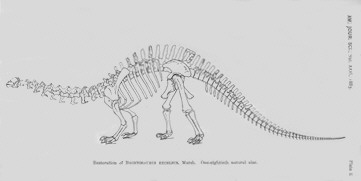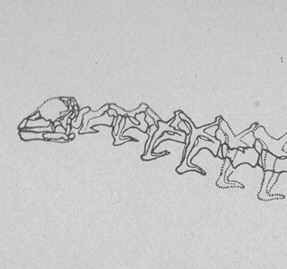18. Sauropods in the American West, 1883
 The
discovery of the Bernissart iguanodons, coupled with earlier evidence
provided by Hadrosaurus and Compsognathus, was pushing the
paleontological world to tip all dinosaurs up onto their hind legs like
gigantic birds. But at this very moment, intrepid explorers in the western
United States were finding indisputable evidence of gigantic dinosaurs
that must have stood firmly on all four feet. They were quickly labelled
as sauropods, since they stood like lizards. The classic specimen of this
new kind of dinosaur was Brontosaurus.
The
discovery of the Bernissart iguanodons, coupled with earlier evidence
provided by Hadrosaurus and Compsognathus, was pushing the
paleontological world to tip all dinosaurs up onto their hind legs like
gigantic birds. But at this very moment, intrepid explorers in the western
United States were finding indisputable evidence of gigantic dinosaurs
that must have stood firmly on all four feet. They were quickly labelled
as sauropods, since they stood like lizards. The classic specimen of this
new kind of dinosaur was Brontosaurus. 
A nearly complete Brontosaurus skeleton was found in Lake Como, Wyoming, in 1879, by parties under the direction of Othniel C. Marsh. Marsh published a full skeletal restoration in 1883. Unfortunately, the skeleton lacked a head when found, so Marsh added a skull that was modelled on one found quite some distance away. We now know that the skull Marsh used belonged to a Camarasaurus, which is quite a bit shorter and wider than the proper skull (see detail at left). Marsh neglected to mention in the text that the restored skull was conjectural; later restorations continued to adopt the Camarasaurus-like skull for nearly a century (see item 41).
In 1877, Marsh had found the bones of another large sauropod, which he had named Apatosaurus. Apatosaurus and Brontosaurus are now recognized to be synonyms, so the later name Brontosaurus is no longer scientifically valid, although it remains in public use.
 Source:
Source:Marsh, Othniel C. "Principal characters of American Jurassic dinosaurs. Part VI: Restoration of Brontosaurus," in: American Journal of Science, series 3, vol. 26 (1883), pp. 81-85. This work is on display as exhibit item 18.


 ®Linda Hall Library
®Linda Hall Library5109 Cherry Street
Kansas City, MO 64110
Please direct comments to ashwortb@lhl.lib.mo.us